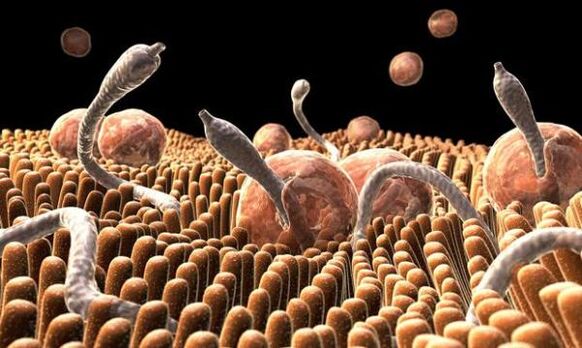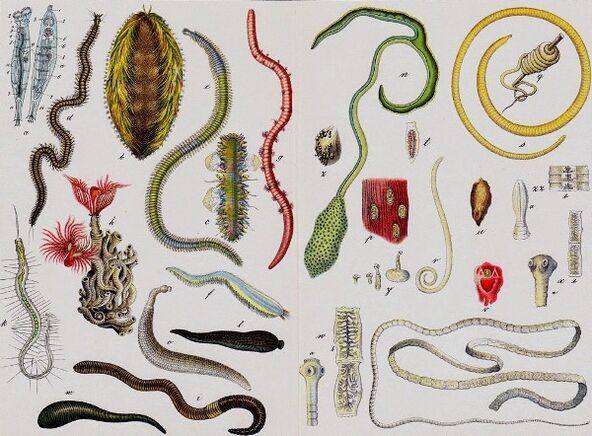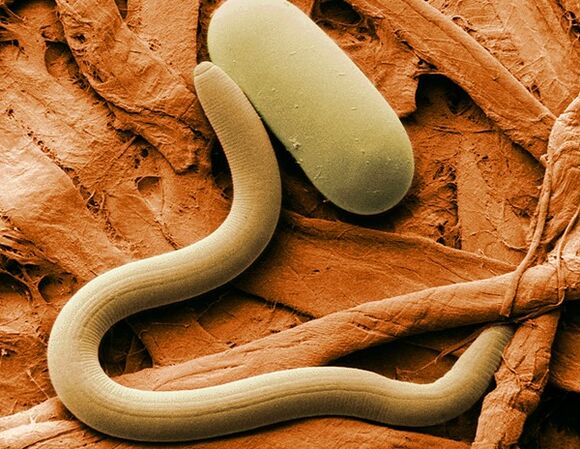Parasites are organisms that exist at the expense of the host. Their life activity in the human body can be asymptomatic. Therefore, helminthic infestation is one of the most rarely diagnosed pathologies.

Parasitic diseases lead to serious consequences. According to the World Health Organization, they cause the death of 16 million people worldwide. In order to promptly detect the parasite and prevent complications, you should know about possible routes of infection and symptoms.
How dangerous are parasites?
Parasites can live both on the body and inside a person. Some varieties are not dangerous, while others pose a serious threat to life. The waste products of helminths have a toxic effect. When there is a large accumulation, the body is poisoned.
Symptoms of parasite intoxication:
- vomit;
- weakness;
- loss of appetite;
- high body temperature;
- fever;
- convulsions.
Treatment must be started on time, because the neglected condition can be fatal.
The consequences of parasitic infection differ depending on the location of the parasite. Worms can cause an allergic reaction, blindness, paralysis, destroy the liver, lungs, brain, and affect the functioning of other organs. They reduce immunity, which makes a person more susceptible to infectious diseases.
The most dangerous parasites:
- Brain amoeba (tape tapeworm). Lives in the brain, life expectancy up to 20 years. As the tapeworm grows, it tends to kill its owner. Mortality occurs in 97% of cases. The worm causes swelling of the brain, and infection can be caused by eating contaminated meat or water.
- Roundworms. Ringed worms, which are often found in the body of a child. Adults grow up to 30 cm in length. Symptoms of general intoxication appear, and you can become infected through dirty hands.
- Onchocercavolvulus. A worm that causes river blindness (onchocerciasis).
- Tryponasoma. Causes chronic heart and intestinal diseases.
- Australian tick. Provokes a severe allergic reaction, leading to respiratory failure.
General symptoms
The most common signs of the presence of parasites are allergic manifestations in the form of urticaria, skin itching, rashes, fever and attacks of bronchial asthma.
General symptoms of parasitosis in the body:
- nausea, vomiting;
- abdominal pain;
- bowel dysfunction (diarrhea or constipation);
- itching in the anus;
- grinding teeth in sleep;
- loss of appetite;
- headache;
- weakness, fatigue;
- avitaminosis;
- decreased immunity;
- anemia;
- cough;
- joint or muscle pain;
- a sharp decrease or increase in body weight.
Symptoms may not appear immediately. For example, clinical signs of infection with pinworms appear after 2-3 days, and with roundworms - after 3 months.
Types of parasites

Parasites can live anywhere in the human body. They are usually found in the intestines and liver, but they can parasitize the lungs, muscle tissue, blood, blood vessels and brain. If the larva gets into the bloodstream, it can attach to any internal organ, disrupting its functioning.
What parasites live in the human body? There are more than 250 species that can live off humans. Their sizes vary from microscopic to meter-long, and their numbers can also vary.
The main types of parasites in humans can be distinguished:
- ectoparasites;
- helminths;
- protozoans (protozoans).
Ectoparasites
This species lives on the skin. Representatives of ectoparasites:
- head, pubic and body louse - pediculosis;
- bedbug – is a carrier of infectious diseases such as hepatitis, tuberculosis, typhoid fever;
- demodex - demodicosis;
- scabies mite - scabies;
- cochlioma – cochliomyasis.
Infection with parasites occurs through contact and household contact. They are transmitted through skin-to-skin contact, through personal hygiene items and clothing. Cochliomyasis occurs when infected by flies, which are common in North and Central America.
Protozoan parasites
These include the following parasites:
- in the intestines - amoebas, lamblia, leishmania, blastocysts, balanditia;
- in the blood - trypanosomes, babesia;
- in the genitourinary system – Trichomonas;
- in internal organs (heart, lungs, liver, brain) - toxoplasma, trypanosomes, acanthamoeba.
Infection occurs through food, water, sexual contact (in the case of Trichomonas).
Helminths
These are worms that, in the course of their life activity, disrupt the functioning of internal organs and metabolism. Worms can be only a few centimeters long or reach 7-10 m.
During primary infection, they settle in the intestines, and during repeated infection they can affect other organs and muscles. The most common worms are those that live in the rectum, liver, bile ducts and lungs.
The most common diseases caused by helminth parasites:
- Ascariasis. The larvae pass through the digestive tract and settle in the intestines. An adult reaches 25-30 cm.
- Opisthorchiasis. Adults infect the bile ducts and enter the human body along with infected fish.
- Cestodosis. Infection caused by tapeworms occurs in humans through meat and fish, affecting the intestines.
- Schistosomiasis. Caused by flukes or flatworms. Infection occurs when water contaminated with freshwater snails comes into contact with the skin.
This species includes a large number of subspecies. In total, more than 300 varieties of helminths have been registered.
They can be grouped into 3 groups:
- nematodes – roundworms;
- trematodes - flukes;
- cestodes are tapeworms.
Nematodes

The most prominent representatives of roundworms:
- pinworms;
- roundworms;
- whipworms.
The main routes of infection with helminths are the consumption of dirty food or contaminated water, unwashed hands, and insect bites. Nematodes settle in the gastrointestinal tract, less often in the liver, lungs and heart.
The main symptoms of the presence of parasites in the human intestine:
- nausea, vomiting;
- itching in the anus;
- skin rashes;
- indigestion;
- chronic fatigue.
When the population is large, parasites leave the body naturally. In this case, nematodes can be found in the stool.
Trematodes
Lead to the emergence of dangerous infectious diseases. These parasites, depending on their habitat, can be divided into the following groups:
- blood flukes - schistosomes;
- liver flukes – liver flukes;
- intestinal flukes;
- pancreatic parasites;
- pulmonary flukes.
Symptoms of infection depend on the organ affected. This may be weakness, dizziness, loss of appetite, nausea, abnormal bowel movements, pale skin, irritability or apathy.
The main source of infection is the release of excrement from sick animals or people into water and soil.
Cestodes
Tapeworms live in the intestines. They enter the human body when consuming insufficiently thermally processed meat and fish. The greatest danger comes from pork tapeworm, which can migrate into the bloodstream, muscle tissue and brain.
Cestodes can parasitize the body for a long time without obvious signs, growing to impressive sizes. The length of an adult is up to 10 m. Common diseases caused by cestodes are avitellinosis and echinococcosis.
Common representatives of cestodes:
- tapeworm;
- bovine and pork tapeworm;
- sheep brain;
- echinococcus.
Which doctor should I contact if I suspect parasites?
Parasitic diseases are treated by parasitologists. They should be contacted if infection is suspected. A dermatologist can also detect parasites on the skin.
Diagnostics
Diagnosis of parasitic worms is carried out using laboratory examination of stool. To identify worms, you will need to be tested three times.
Pinworm parasites are identified by scraping, which is performed with adhesive tape. Organs that are not involved in digestion can be checked for parasites using a blood test or biopsy.
Treatment
You can cleanse the human body of parasites with the help of medications and folk remedies. The duration of treatment depends on the degree of infection and intoxication of the body.
Drug treatment of parasites
Treatment of helminthiasis involves the use of anthelmintics. They are toxic, so they cannot be used without a confirmed diagnosis.
Symptoms of helminthiasis can be relieved with symptomatic treatment. Vitamin preparations, choleretic agents, hepatoprotectors, laxatives, antiallergic medications, antibiotics, and probiotics are used.
For severe allergic reactions, corticosteroids are prescribed.
Traditional treatment of parasites
You can get rid of parasites in the human body using the following traditional medicine:
- Enema with cranberry juice. It helps get rid of helminths and protozoa. For 2 liters of water you need to take 2 tbsp. l. cranberry juice and 1 tbsp. l. salt. Do the procedure 2 times a day.
- Garlic enema. You can get rid of intestinal parasites in this way - boil 6 cloves of garlic in 1 liter of milk, cool and do an enema.
- Pumpkin seeds. Peeled seeds (300 g) must be crushed, add a small amount of water, and add 100 g of honey. Eat at one time together with a laxative.
- Onion infusion. Chop a large onion into pieces, pour boiling water over it, and leave for 12 hours. Drink 100 g 3-4 times a day.
To remove parasites from the stomach and intestines, you need to eat spicy food. By consuming garlic, onions, hot spices and herbs, you can easily get rid of pinworms, for example.
Complications
Parasites negatively affect the human body. If helminthiasis is not treated, severe complications arise:
- frequent acute respiratory viral infections, enlarged adenoids and tonsils;
- appendicitis;
- enteritis, gastroenteritis, enterocolitis;
- cirrhosis;
- liver cancer;
- anemia;
- gastrointestinal bleeding;
- pancreatitis;
- bronchitis;
- oncological diseases;
- cerebral edema;
- purulent-septic lesions.
The vital activity of parasites in the stomach leads to peritonitis, in the lungs – to pneumonia. Roundworms clog the respiratory and bile ducts, causing suffocation or intestinal obstruction.
Prevention
Preventive measures against parasite infection:
- wash your hands before eating and after going outside;
- consume only washed vegetables and fruits, boiled water;
- store food in compliance with sanitary standards, avoid contact with flies;
- eat meat and fish only after heat treatment;
- do not swim in polluted waters;
- do not use other people’s personal hygiene products;
- carry out deworming of pets.
Although worms pose a threat to human health and life, cleansing the body of them should only be done after the parasites are detected and under the supervision of a doctor. Timely diagnosis of helminthiasis will help avoid serious complications. It is important to take preventive measures, especially in children.
FAQ
What symptoms may indicate the presence of parasites in the human body?
Some common symptoms of parasitic infections may include fatigue, weakness, weight loss, abdominal pain, upset stomach, allergic reactions, and changes in appetite and sleep.
What signs may indicate the presence of parasites in the human body?
Signs of parasites in the body may include the presence of parasites in stool, blood tests, and symptoms of specific parasitic infections such as malaria, trichinosis, and others.
How can parasites in the human body be treated?
Treatment for parasites in the human body may include taking anti-parasitic medications under medical supervision, as well as hygiene and prevention measures to prevent re-infection.
Useful tips
Tip #1
Pay attention to symptoms such as constant fatigue, loss of appetite, abdominal pain, weight changes, allergic reactions - these may be signs of the presence of parasites in the body.
Tip #2
Conduct a special examination with a doctor to identify parasites. This may include stool, blood, urine tests, ultrasound and other diagnostic methods.
Tip #3
When treating parasites, consult your doctor for appropriate medications and recommendations for diet and lifestyle.




























